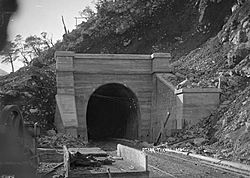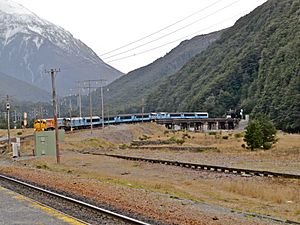Otira Tunnel facts for kids
 |
|
| Otira Tunnel during construction, ca 1910 | |
| Overview | |
|---|---|
| Line | Midland Line |
| Location | Southern Alps, South Island, New Zealand |
| Coordinates | North (West coast) portal: 42°51′45″S 171°32′55″E / 42.8625°S 171.5487°E East (Canterbury) portal: 42°56′21″S 171°33′47″E / 42.9392°S 171.5630°E |
| Start | Otira, West Coast |
| End | Arthur's Pass Canterbury |
| Operation | |
| Operator | KiwiRail, The Great Journeys of New Zealand |
| Character | Single bore rail tunnel |
| Technical | |
| Line length | 8566 m |
| Gauge | 1067 mm (3' 6") |
The Otira Tunnel is a railway tunnel in New Zealand's South Island. It's part of the Midland Line and connects the towns of Otira and Arthur's Pass. This long tunnel goes right under the Southern Alps.
The tunnel is more than 8.5 kilometers (about 5.3 miles) long. It has a steep slope, mostly 1 in 33. The Otira end of the tunnel is over 250 meters (about 820 feet) lower than the Arthur's Pass end.
Building the Otira Tunnel
Work on the Otira Tunnel began in 1907. A special "breakthrough" celebration happened on August 21, 1918. This was when the two ends of the tunnel finally met in the middle. The tunnel officially opened on August 4, 1923. At that time, it was the seventh longest tunnel in the world. It was also the longest tunnel in the entire British Empire.
Engineers looked at many ways to build a railway line over the mountains. They thought about a line with very steep slopes or even a special cable system. However, the government decided in 1900 to build a long, straight tunnel. After more advice, they chose an 8.55-kilometer tunnel with a slope of 1 in 33.
A company called John McLean and Sons started building the tunnel in 1908. They used a method called "drill and blast." This means they drilled holes into the rock, placed explosives, and then blasted the rock away. Building the tunnel was very hard and slow work. The company struggled and eventually had to stop in 1912. The New Zealand government's Public Works Department then took over the project.
Even during World War I, work on the tunnel continued. The British government asked New Zealand to keep building it. This was important in case German ships blocked the ports used for shipping coal. The two sides of the tunnel met on July 20, 1918. However, it took three more years to line the tunnel with concrete. Then, it took another two years before trains could use it. Sadly, eight people died during the tunnel's construction.
How the Tunnel Works Today
The Otira Tunnel is 4.72 meters (about 15 feet 6 inches) high. It is 4.27 meters (about 14 feet) wide at the bottom. Because the tunnel is so long and has a slope, dangerous gases could build up from steam trains. These gases, like carbon dioxide, would make it unhealthy for people and difficult for trains to operate.
To solve this problem, the tunnel was electrified. This meant electric trains could use it instead of steam trains. A special system of wires above the tracks provided 1500 V DC electricity. A small power station was built near Otira to make this electricity. Later, the tunnel was connected to New Zealand's main power grid. Electric locomotives, like the EO class and later the EA class, pulled trains through the tunnel.
In 1988, railway workers started testing DX class diesel locomotives. They wanted to see if these could replace the electric trains. After more tests in 1991, they found that with some upgrades to the diesel engines and large fans at the tunnel entrance, the diesel trains could work.
Because the electric system was getting old, it was removed in 1997. This was the end of electric trains in the South Island.
Now, to deal with the fumes from diesel trains, a special system is used. It's like the one in the Cascade Tunnel in the United States. When a train enters the tunnel from the Otira end, a large door closes behind it. Then, a powerful fan sucks out the fumes from behind the train. Once the air is clear, the door opens again. Because of these fumes, the TranzAlpine train's special observation cars are closed when going through the tunnel.


